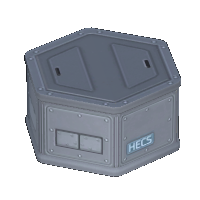Probodobodyne HECS
| Probodobodyne HECS | |||||
| Command module by Probodobodyne Inc | |||||
| Radial size | Tiny | ||||
| Cost | (total) | 650.00 | |||
| Mass | (total) | 0.100 t | |||
| Drag | 0.15-0.2 | ||||
| Max. Temp. | 1200 K | ||||
| Impact Tolerance | 12 m/s | ||||
| Research | | ||||
| Unlock cost | 4 900 | ||||
| Since version | 0.21 | ||||
| Part configuration | probeCoreHex_v2.cfg | ||||
| Electricity required | 1.50 ⚡/min | ||||
| Torque | 0.5 kN·m | ||||
| Electricity required |
| ||||
| SAS level | 1 | ||||
| Field of View | (min) | 17 ° | |||
| (max) | 63 ° | ||||
| Anomaly detection | 12 % | ||||
| Enhanceable | No | ||||
| Mode | Terrain | ||||
| Antenna type | Internal | ||||
| Antenna rating | 5 km | ||||
| Packed volume | 200 l | ||||
| Electric capacity | 10 ⚡ | ||||
The Probodobodyne HECS is an unmanned command module that runs on electricity.
Contents
[hide]Product description
| “ | The HECS core capabilities go far beyond its sleek, 6-sided futuristic casing. This probe core provides advanced guidance assistance technology, and comes fitted with internal reaction wheels and decently-sized batteries. Despite concerns that one day, autonomous spacecraft cores could become self-aware and turn against their creators, or even become very stubborn against opening pod bay doors, Probodobodyne insists that these unmanned AI-driven devices are the way of the future. — Probodobodyne Inc |
” |
Usage
Generally placed near the top of the rocket, the Probodobodyne HECS provides full command module functionality with a tiny connector on the top and bottom. Its six-sided shape is better suited to three- or six-way symmetry when attaching parts.
The HECS is usually able to replace the similar Probodobodyne OKTO as an upgrade. It has the same stack size, mass and electricity storage. Compared to the OKTO, the HECS has an internal reaction wheel that is 66% stronger; in addition, it is capable of prograde and retrograde hold SAS, which is very helpful during the rocket's launch or re-entry. Finally, it has a wider range of FoV options in KerbNet, and has twice the OKTO's detection rate. These useful benefits come at the small drawback of increased electrical usage, both by the probe core and by its reaction wheel.
Trivia
- As of version 1.12.2, both the old probeCoreHex cfg file and the new probeCoreHex_v2 cfg file can be found in the game's Parts folder.
- This is intended to provide backwards compatibility with old craft still using the old HECS part.
Changes
- New model and texture
- Added KerbNet
- Initial Release
| ||||||||||||||||||||||||||||||||||||||||||||||||||||||||||||||||||||||||||||||||||
